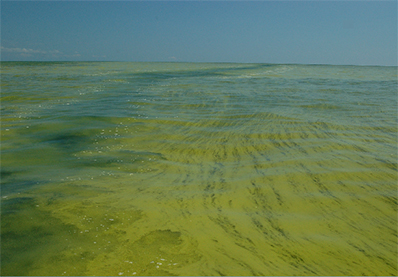Lab tests public water for algae toxins

Under the Safe Drinking Water Microcystins Analytical Support contract, the lab is testing raw drinking water samples for total microcystins— toxins that can be produced by cyanobacteria, commonly referred to as blue-green algae.
Harmful algal blooms have become a growing concern nationwide, in part because of increased awareness after high profile cases, including one in Ohio in 2014, said Dustin May, Radiochemistry and Nutrient Demand Laboratory supervisor.
The toxins can cause illnesses including nausea, vomiting and diarrhea, and potential kidney and liver failure in pets, livestock and people.
"This issue is not a new phenomenon," May said. "It's been around a long time."
The project, however, is new and is the first full study the state has conducted on microcystins in drinking water, said Kathleen Lee, Senior Environmental Specialist with the Iowa Department of Natural Resources.
Lee said the screening was made available free of charge to Iowa public water supply systems that source their drinking water from lakes, rivers or other surface water, or from groundwater influenced by surface water. Federal funding is through the Environmental Protection Agency.
The new program is particularly helpful in places such as Spirit Lake that has a history of blue-green algae in Big Spirit Lake, the city’s water source.
Darin Peterson, water superintendent for Spirit Lake Waterworks, said the plant has not had any issues with its treated water, but began voluntarily testing for the toxins related to blue-green algae last year, in response to the problems in Ohio. In the Ohio case, toxins from algal blooms in Lake Erie contaminated Toledo’s public water supply, making drinking water unsafe for about 500,000 people.
"Whenever it comes to water quality, our primary concern is good, healthy water for our community," he said, adding that the plant serves nearly 5,000 customers in northwestern Iowa.
Peterson said the plant has not had to adjust its treatment process in response to elevated levels of microcystins, but enrolled in the voluntary sampling program as another safeguard for its water quality.
"We keep a close watch all the time," he said.
The Safe Drinking Water Act requires states and public water supplies to monitor for contaminants with known human health effects. The EPA recently established health advisories for some toxins, and the Iowa DNR has developed protocols using these health advisory levels to protect the public.
In all, 25 Iowa public water supplies are participating, from Council Bluffs in the western part of the state to Davenport in the east.
The samples are collected and stored in amber glass bottles to prevent photosynthesis and replication by the algae. Tests are conducted at the State Hygienic Laboratory in a closed, dark lab room, because the toxins themselves are light sensitive and can undergo photodegradation. The color solution used in the screening process also is sensitive to light.
Four staff members are trained to perform the screenings, which will be performed one to two times per week for one year. An Enzyme-Linked Immunosorbent Assay, known as ELISA, is used to detect the presence of the toxin in the sample.
May said tests on treated water are conducted if microcystins are detected in the raw water samples.
If needed, further treatment, such as granular activated carbon filtering, can be added to existing plant operations to remove the toxins from the water.
In the first week of testing, microcystins were detected in raw water samples from four of the 25 participating facilities, according to IDNR’s Lee.
Harmful algal blooms can form in warm, slow-moving bodies of water with heavy concentrations of phosphorus and nitrogen from sources such as fertilizer runoff, septic tank overflows, industry pollutants and manure that have washed into the waterways.
The surface scum can look like spilled paint and may have green globs floating beneath the surface. Climate change is thought to be associated with an increase in algal blooms.
"The incident in Ohio really brought this to people's attention," Lee said, adding that Iowa also has had concerns with algal blooms.
The new effort differs from Iowa's State Park Beach Monitoring Program, in which the DNR samples and reports on bacterial concentrations and microcystins at swimming areas throughout the state. It contracts with the Hygienic Lab to provide analytical services for E. coli testing at 40 state-owned beaches and participating county- or city-owned beaches.
Lee said the new Iowa drinking water project is voluntary, and reviews of the data will be conducted at six months and a year to determine the next steps.
"Overall, the drinking water in Iowa is very safe," she said. "Currently, there is no requirement in the Safe Drinking Water Act to monitor for algal toxins in raw or treated drinking water. We're doing this to be proactive."



